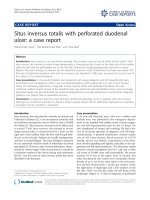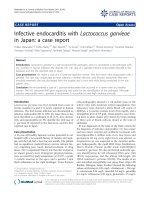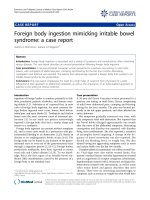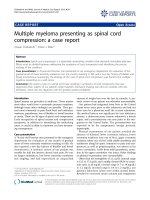Báo cáo y học: "The skiers knee without swelling or instability, a difficult diagnosis: a case report" potx
Bạn đang xem bản rút gọn của tài liệu. Xem và tải ngay bản đầy đủ của tài liệu tại đây (531.88 KB, 4 trang )
BioMed Central
Page 1 of 4
(page number not for citation purposes)
Journal of Medical Case Reports
Open Access
Case report
The skiers knee without swelling or instability, a difficult diagnosis:
a case report
Mark E O'Donnell*
1,4
, Stephen A Badger
1
, David Campbell
2
, Willie Loan
2
and Brendan Sinnott
3
Address:
1
Department of Surgery, Belfast City Hospital, Lisburn Road, Belfast BT9 7AB. Northern Ireland, UK,
2
Department of Radiology, Belfast
City Hospital, Lisburn Road, Belfast BT9 7AB. Northern Ireland, UK,
3
Department of Emergency Medicine, Belfast City Hospital, Lisburn Road,
Belfast BT9 7AB, Northern Ireland, UK and
4
DSEM MFSEM(UK) MRCSEd, 42 Woodrow Gardens, Saintfield, Co Down, BT24 7WG, Northern
Ireland, UK
Email: Mark E O'Donnell* - ; Stephen A Badger - ; David Campbell -
i.nhs.uk; Willie Loan - ; Brendan Sinnott -
* Corresponding author
Abstract
Skiing as a recreational activity has increased exponentially in the last twenty-years. Similar to any
sporting activity, participants can sustain various types of injury, which provides the emergency
departments with a continuous supply of patients. The injury pattern from the slopes has also
changed over this time period, due to alterations and improvements in ski equipment. An increased
diversity in alpine skiing techniques, as well as snowboarding and cross-terrain disciplines has also
influenced this change.
We present a multi-media experience of a high-speed ski fall that caused a valgus-external rotation
injury to the right knee that precluded the patient from further ski activity. There was no bruising,
swelling or instability demonstrated and the patient returned to ski activities 24-hours post-injury.
Although this injury appeared clinically benign initially, the patient complained of persistent pain
around the right knee which was causing occupational difficulties. Following normal clinical
assessment, the patient returned to work but continued to complain of persistent pain at the lateral
aspect of the right knee. Magnetic Resonance Imaging (MRI) demonstrated extensive bone marrow
oedema (BMO), a mild depression of the articular cortex compression with a small focus of
articular cartilage disruption and microfractures of the lateral tibial plateau. The patient was treated
conservatively and remains well with avoidance of impact exercises 14-months post-injury.
In the presence of any high speed injury, we would stress that regardless of initial normal
investigations, clinical suspicion should remain paramount and not deter the physician from further
investigation in the presence of continuing symptomatology.
Background
A 30 year-old male presented to the Accident and Emer-
gency Department in March 2006 with persisting right
knee pain. He described a high-speed fall during a ski hol-
iday in January 2006 in which he sustained a valgus-exter-
nal rotation knee injury (Additional file 1). His height was
168 cm and weight was 74 kg. He had a background of
Alpine Ski Racing and stated that this was "the worst fall
Published: 20 April 2007
Journal of Medical Case Reports 2007, 1:11 doi:10.1186/1752-1947-1-11
Received: 13 December 2006
Accepted: 20 April 2007
This article is available from: />© 2007 O'Donnell et al; licensee BioMed Central Ltd.
This is an Open Access article distributed under the terms of the Creative Commons Attribution License ( />),
which permits unrestricted use, distribution, and reproduction in any medium, provided the original work is properly cited.
Journal of Medical Case Reports 2007, 1:11 />Page 2 of 4
(page number not for citation purposes)
in 27-years and that he was unable to continue skiing".
On assessment at the resort, maximal tenderness was elic-
ited around the lateral tibial plateau and mid-tibial
region. However, there was no evidence of bruising, swell-
ing or joint instability. He was otherwise well with no pre-
vious history of trauma or musculoskeletal injuries. He
was commenced on regular non-steroidal analgesics and
returned to the slopes after a 24-hour rest period with a
semi-rigid protection knee brace.
On return from the holiday, the patient described persist-
ent pain around the lateral aspect of the knee joint radiat-
ing down to the mid-tibial region which was exacerbated
by prolonged standing. The discomfort from the injury
was now precluding him from his occupation which
involved prolonged procedures in the standing position.
On assessment in the Accident and Emergency Depart-
ment 6-weeks following the injury, tenderness was again
elicited around the lateral aspect of the knee and mid-tibia
with no clinical evidence of a haemarthrosis or joint insta-
bility. Plain radiographs of the knee joint were normal
(Figure 1 – Lateral View). The pain continued to persist
necessitating further investigation. MRI demonstrated
extensive BMO within the lateral tibial plateau extending
to the articular surface and involving the tibial spine.
There was a mild depression of the articular cortex of the
lateral tibial plateau anteriorly with further compression
microfractures in the deeper trabecular bone. There was
also a small focus of articular cartilage disruption but no
major cartilaginous defect (Figures 2 &3).
Immobilization of the joint in the post-injury period was
advised by the othopaedic team. As it was more than 6-
weeks following the injury, he was therefore advised to
mobilise as tolerated with an arthropad support. The
patient remains well 14-months following the injury and
has minimal difficulty on prolonged standing. Impact
training still exacerbates the discomfort around the right
knee joint, and he prefers to continue with non-impact
exercises.
Discussion
There has been an increase in total ski injuries treated
within emergency units over the last 20-years reflecting
the unprecedented increase in alpine skiing popularity. In
2002, an estimated 77,300 skiing- and 62,000 snow-
boarding-related injuries were treated in the US hospital
emergency departments [1]. However, with improved
safety of ski equipment for everyone from the novice
beginner to the more adept racer, the actual incidence has
declined in this period. Although there has been a 60%
decrease in total lower extremity injury incidence, knee
ligamentous injuries still occur frequently and account for
the largest percentage of lower limb injuries [2]. Most
injuries occur in male participants between the ages of
10–24 years of age. However, Xiang et al state that the
actual higher rate occurs among skiers aged 55–64 when
injury analysis is completed correlating for the actual
number of participants for each age group [1].
The clinical history of knee injury in skiers will often
present the diagnosis with 90% accuracy [2]. Various fac-
tors guide the clinician to the diagnosis such as the force
and type of fall (twisting, hyperextension, or falling back-
ward), whether a "pop" was heard by the skier, the pres-
ence of instability after the fall and any associated
swelling. In this case, the patient complained of pain fol-
lowing an external-rotation injury and described no actual
feeling of joint instability or swelling. The mechanism of
most knee injuries, as in this case, usually involves fixa-
tion of the distal extremity resulting in subsequent
enhancement of the forces necessary to generate an injury.
The conventional radiographic knee series has tradition-
ally been the method of choice in the initial radiological
evaluation of patients with acute knee injury. The images
required in a knee series varies between institutions from
Plain Lateral Radiograph of the right knee demonstrating no obvious bony injuryFigure 1
Plain Lateral Radiograph of the right knee demonstrating no
obvious bony injury.
Journal of Medical Case Reports 2007, 1:11 />Page 3 of 4
(page number not for citation purposes)
2 to 6 images with no conclusive algorithm depicting
which views should be included. In our institution, only
antero-posterior (AP) and lateral knee views are recorded.
Verma et al describe a lateral view as the most appropriate
radiograph for screening knee trauma with a sensitivity for
depicting knee fractures of 100%, and a negative predic-
tive value of 100% in their study population with a 24.8%
prevalence of knee fractures [3]. Although specificity was
not the aim of Verma's study, they recommended MR
imaging if clinical suspicion persisted in the present of
inequitable radiograms. In this case, both AP and lateral
views demonstrated no obvious bony injury. However,
with the continuation of symptoms MR imaging was sub-
sequently performed which demonstrated extensive
BMO, a depression fracture of the articular cortex and fur-
ther compression microfractures within the lateral tibial
plateau. BMO secondary to sporting activities is most fre-
quently related to trauma with an incidence between 27%
and 72% after acute injuries [4]. The pathophysiology of
BMO relates to the actual mechanism of injury and can
occur in the acute or chronic setting. Impaction injuries,
as seen in this case, are due to direct trauma which causes
one bone to impact on another and results in extensive
BMO involving a broad surface of the involved bony
structures. Avulsive or distraction injuries are usually due
to valgus, varus rotational stresses on a joint which causes
a small avulsion fracture related to a tendinous, ligamen-
tous or capsular attachment on the bone. The resultant
BMO is less extensive as cortical rather than trabecular
bone is involved. It is important to note that conventional
X-rays are often more beneficial in these cases as the
avulsed fragment may be very difficult to detect on MRI.
Clinically, a combination of BMO patterns is usually evi-
dent as the impaction type is encountered at the force
entry site whereas the distraction type is identified with
possible underlying ligamentous injury at the force exit
site [4].
Injuries that normally require surgical intervention
include meniscal tears, anterior cruciate ligament tears,
chrondral defects, and less often collateral ligament inju-
ries. [1] The management of tibial plateau fractures on the
other hand is a long subject of controversy. The spectrum
of treatment ranges from simple casting and bracing to
skeletal traction and early motion to open reduction and
internal fixation (ORIF) [5]. Ebraheim et al's indication
for surgery was dependant on the patient's age, medical
status, presence of osteoporesis, degree of displacement
and depression, pre-injury activity level, and occupation
rather than solely on the Schatzker classification [6] for
tibial plateau fractures. As the largest operative series to
date, Ebraheim et al recommend ORIF only for those tib-
ial plateau fractures with significant displacement [5].
Coronal STIR sequence MRI demonstrating extensive bone marrow oedema within the lateral tibial plateau extending to the articular cartilageFigure 3
Coronal STIR sequence MRI demonstrating extensive bone
marrow oedema within the lateral tibial plateau extending to
the articular cartilage.
Sagittal T1-weighted sequence MRI demonstrating extensive bone marrow oedema within the lateral tibial plateau extend-ing to the articular cartilageFigure 2
Sagittal T1-weighted sequence MRI demonstrating extensive
bone marrow oedema within the lateral tibial plateau extend-
ing to the articular cartilage.
Publish with BioMed Central and every
scientist can read your work free of charge
"BioMed Central will be the most significant development for
disseminating the results of biomedical research in our lifetime."
Sir Paul Nurse, Cancer Research UK
Your research papers will be:
available free of charge to the entire biomedical community
peer reviewed and published immediately upon acceptance
cited in PubMed and archived on PubMed Central
yours — you keep the copyright
Submit your manuscript here:
/>BioMedcentral
Journal of Medical Case Reports 2007, 1:11 />Page 4 of 4
(page number not for citation purposes)
The extensive BMO with associated microfractures identi-
fied on the MRI are synonymously known as bone bruises
or contusions which are often used as secondary signs for
detecting other associated abnormalities. They are best
diagnosed by MRI with an increased signal intensity on fat
suppressed T2-weighted images (eg. Short Tau Inversion
Recovery, or STIR), and decreased signal intensity on T1-
weighted images. T2-weighted images reflect the presence
of free water (oedema or inflammatory response) and
haemorrhage and are therefore useful to determine how
acute the injury is. Bone bruises can be classified using
MRI as Type I when the injury is diffuse, often reticular
with alterations to the medullary component distant from
the subadjacent articular surface, Type II which is defined
as localized or geographical signal abnormality with con-
tiguity to articular surface and type III as disruption or
depression of the normal contour of the cortical surface/
subchondral lamella, often associated with a Type II
lesion [7].
In this case, MRI demonstrated minimal displacement of
the articular cortex and ORIF was not indicated. The clin-
ical significance, time required for resolution, long-term
consequences to articular cartilage and the most appropri-
ate initial treatment for bone bruises still await long-term
follow-up studies. However, shorter-term studies
reviewed by Mandalia et al stated that bone bruising has a
variable time for resolution from as early as 3-weeks to 2-
years [8]. They also suggested that bone bruising and
other associated injuries can lead to deleterious effects on
future cartilaginous metabolism and osteoarthritis in the
longer term. However, these factors still require further
study.
Conclusion
The presence of persistence knee pain following a high-
speed injury should alert the physician to consider further
investigations even in the absence of obvious clinical
signs or radiological findings. Treatment should be symp-
tomatic with an initial period of immobilization recom-
mended.
Competing interests
The author(s) declare that they have no competing inter-
ests.
Authors' contributions
MEOD: Involved in the conception of the report, litera-
ture review, manuscript preparation, manuscript editing
and manuscript submission. SAB: Involved in the manu-
script preparation and manuscript editing. DC: Involved
in the critical analysis of radiological imaging in both the
case report and discussion, manuscript editing and manu-
script review. WL: Involved in the manuscript editing and
manuscript review. BL: Involved in the critical review of
the literature for sporting injuries of the knee, manuscript
editing and manuscript review. All authors have read and
approved the final manuscript.
Additional material
Acknowledgements
Consent was obtained from the patient for the publication of this study.
References
1. Xiang H, Kelleher K, Shields BJ, Brown KJ, Smith GA: Skiing- and
Snowboarding-Related Injuries Treated in the U.S Emer-
gency Departments, 2002. J Trauma 2005, 58:112-118.
2. Steadman JR, Sterett WI: The surgical treatment of knee inju-
ries. Med Sci Sports Exerc 1995, 27:328-33.
3. Verma A, Su A, Golin AM, O'Marrah B, Amorosa JK: The Lateral
View: A screening method for knee trauma. Acad Radiol 2001,
8:392-397.
4. Vanhoenacker FM, Snoeckx A: Bone marrow edema in sports:
General concepts. Eur J Radiol 2007. doi:10.10.16/
j.ejrad.2007.01.013.
5. Ebraheim NA, Sabry FF: Open reduction and internal fixation of
117 tibial plateau fractures. Orthopaedics 2004, 27:1281-7.
6. Schatzker J, McBroom R, Bruce D: The tibial plateau fracture.
The Toronto experience 1968–1975. Clin Orthop 1979,
138:94-104.
7. Costa-Paz M, Muscolo DL, Ayerza M, Makino A, Aponte-Tinao L:
Magnetic resonance imaging follow-up study of bone bruises
associated with anterior cruciate ligament ruptures. Arthros-
copy 2001, 17:445-9.
8. Mandalia V, Fogg AJB, Chari R, Murray J, Beale A, Henson JHL: Bone
bruising of the knee. Clinical Radiology 2005, 60:627-36.
Additional File 1
Reduced speed footage documenting the actual valgus-external rotation
force on the right knee.
Click here for file
[ />1947-1-11-S1.movi]









